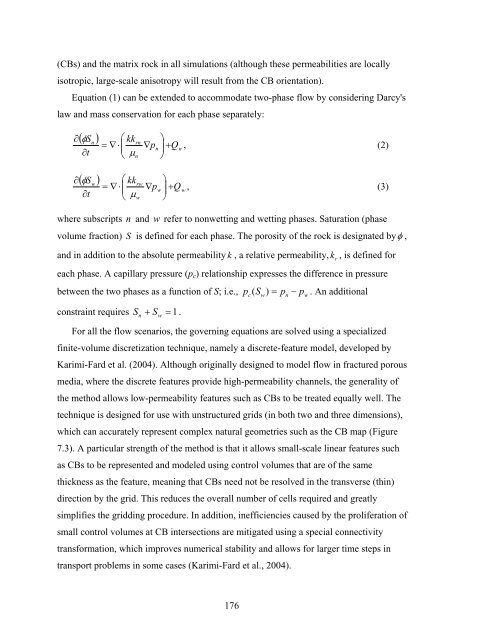structural geology, propagation mechanics and - Stanford School of ...
structural geology, propagation mechanics and - Stanford School of ...
structural geology, propagation mechanics and - Stanford School of ...
You also want an ePaper? Increase the reach of your titles
YUMPU automatically turns print PDFs into web optimized ePapers that Google loves.
(CBs) <strong>and</strong> the matrix rock in all simulations (although these permeabilities are locally<br />
isotropic, large-scale anisotropy will result from the CB orientation).<br />
Equation (1) can be extended to accommodate two-phase flow by considering Darcy's<br />
law <strong>and</strong> mass conservation for each phase separately:<br />
( φS<br />
)<br />
∂<br />
∂t<br />
( φS<br />
)<br />
∂<br />
∂t<br />
⎛ kk<br />
= ∇⋅<br />
⎜<br />
⎝<br />
∇<br />
⎞<br />
⎟<br />
⎠<br />
n rn<br />
⎜ pn<br />
⎟ + Qn<br />
µ n<br />
⎛ kk<br />
= ∇⋅<br />
⎜<br />
⎝<br />
∇<br />
⎞<br />
⎟<br />
⎠<br />
w rw<br />
⎜ pw<br />
⎟ + Q w<br />
µ w<br />
, (2)<br />
, (3)<br />
where subscripts n <strong>and</strong> w refer to nonwetting <strong>and</strong> wetting phases. Saturation (phase<br />
volume fraction) S is defined for each phase. The porosity <strong>of</strong> the rock is designated byφ<br />
,<br />
<strong>and</strong> in addition to the absolute permeability , a relative permeability, k , is defined for<br />
k r<br />
each phase. A capillary pressure (pc)<br />
relationship expresses the difference in pressure<br />
between the two phases as a function <strong>of</strong> S; i.e., pc( Sw)<br />
= pn<br />
− pw<br />
. An additional<br />
constraint requires Sn<br />
+ Sw<br />
= 1 .<br />
For all the flow scenarios, the governing equations are solved using a specialized<br />
finite-volume discretization technique, namely a discrete-feature model, developed by<br />
Karimi-Fard et al. (2004). Although originally designed to model flow in fractured porous<br />
media, where the discrete features provide high-permeability channels, the generality <strong>of</strong><br />
the method allows low-permeability features such as CBs to be treated equally well. The<br />
technique is designed for use with unstructured grids (in both two <strong>and</strong> three dimensions),<br />
which can accurately represent complex natural geometries such as the CB map (Figure<br />
7.3). A particular strength <strong>of</strong> the method is that it allows small-scale linear features such<br />
as CBs to be represented <strong>and</strong> modeled using control volumes that are <strong>of</strong> the same<br />
thickness as the feature, meaning that CBs need not be resolved in the transverse (thin)<br />
direction by the grid. This reduces the overall number <strong>of</strong> cells required <strong>and</strong> greatly<br />
simplifies the gridding procedure. In addition, inefficiencies caused by the proliferation <strong>of</strong><br />
small control volumes at CB intersections are mitigated using a special connectivity<br />
transformation, which improves numerical stability <strong>and</strong> allows for larger time steps in<br />
transport problems in some cases (Karimi-Fard et al., 2004).<br />
176
















